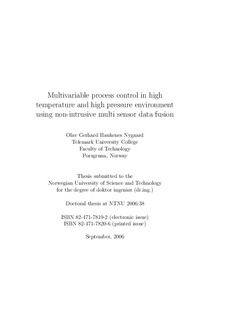| dc.contributor.advisor | Mylvaganam, Saba | nb_NO |
| dc.contributor.author | Nygaard, Olav Gerhard Haukenes | nb_NO |
| dc.date.accessioned | 2014-12-19T13:29:19Z | |
| dc.date.available | 2014-12-19T13:29:19Z | |
| dc.date.created | 2006-02-07 | nb_NO |
| dc.date.issued | 2006 | nb_NO |
| dc.identifier | 121909 | nb_NO |
| dc.identifier.isbn | 82-471-7819-2 | nb_NO |
| dc.identifier.uri | http://hdl.handle.net/11250/249679 | |
| dc.description.abstract | The main objective of this thesis is to use available knowledge about a process and combine this with measurement data from the same process to extract more information about the process. The combination of knowledge and measurement data is referred to as Multi Sensor Data Fusion, MSDF. This added information is then used to control the process towards a specified goal.
The process studied in this thesis is the process of drilling wells in a petroleum reservoir, while the oil is flowing from the reservoir. In the petroleum industry, this is defined as underbalanced drilling (UBD), where the bottom hole pressure (BHP) in the well is below the pore pressure in the reservoir.
Detailed knowledge of the process is of paramount importance when using multi sensor data fusion. Due to this, various process modelling efforts are examined and evaluated, from simple relations between parameters to a finite-element approach of modelling the fluid flow in the well during drilling. Several sensors are used in the various cases, and existing sensors such as pressure sensors and flow sensors are the main data source in the analysis. Future scenario with sensors such as pressure arrays and non-intrusive multiphase flow meters are evaluated. In addition, new positions of existing sensor systems are discussed.
The methods available for fusing the knowledge of the process represented as models together with the available data is ranging from artificial intelligent methods such as neural networks, to methods incorporating statistical analysis such as various Kalman filters. History matching techniques using gradient techniques are also examined.
The migration of reservoir fluids into the well during UBD influences the BHP of the well. The results in the thesis show that this reservoir influx can be calculated by estimating some of the important reservoir parameters such as reservoir pore pressure or reservoir permeability. These reservoir parameters can be estimated most efficiently by performing an MSDF using a detailed nonlinear model of the well and reservoir dynamic behaviour together with real-time measurements of the fluid flow parameters such as fluid temperature, fluid pressure and fluid flow rates. The unscented Kalman filter shows the best performance when evaluating both estimation accuracy and computational requirements.
Regarding available instrumentation for use during UBD, the analysis shows that there is a major potential in introducing new sensors. As new data transmission methods are emerging and making data from sensors distributed along the drillstring available, this can generate a shift in paradigm regarding real-time analysis of reservoir properties during drilling.
Controlling the process is an important usage of the information gained from the MSDF analysis. Various control methods for controlling the most important process variables are examined and evaluated. The results show that acceptable pressure control can be obtained when using the choke valve opening as the primary control parameter. However, the choke valve operation has to be closely coordinated with drilling fluid flow rate adjustments. The choke valve opening control is able to compensate for pressure variations during the whole drilling operation.
A suggested nonlinear model predictive control algorithm gives best results when looking at the control accuracy, and can easily be expanded to handle multiple control inputs and system constraints. This control algorithm uses a detailed model of the well and reservoir dynamics. The Levenberg-Marquardt algorithm is used to calculate the optimal future control variables. The main drawback of the control algorithm is computational burden. A linear control algorithm, which also is evaluated, uses less computational resources, but has less control accuracy and is more difficult to expand into a multivariable control system.
Recommendations for further work are to expand the suggested model predictive control algorithm to handle more control inputs, while reducing the computational burden by incorporating low-order models for describing the future behaviour of the well. | nb_NO |
| dc.language | eng | nb_NO |
| dc.publisher | Fakultet for informasjonsteknologi, matematikk og elektroteknikk | nb_NO |
| dc.relation.ispartofseries | Doktoravhandlinger ved NTNU, 1503-8181; 2006:38 | nb_NO |
| dc.subject | Cybernetics Petroleum Process Control Kalman Estimation | en_GB |
| dc.subject | TECHNOLOGY: Engineering physics | en_GB |
| dc.title | Multivariable process control in high temperature and high pressure environment using non-intrusive multi sensor data fusion | nb_NO |
| dc.type | Doctoral thesis | nb_NO |
| dc.source.pagenumber | 180 | nb_NO |
| dc.contributor.department | Norges teknisk-naturvitenskapelige universitet, Fakultet for informasjonsteknologi, matematikk og elektroteknikk | nb_NO |
| dc.description.degree | dr.ing. | nb_NO |
| dc.description.degree | dr.ing. | en_GB |
